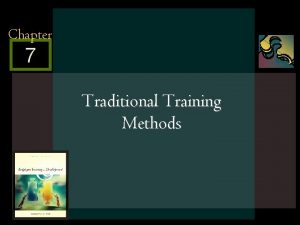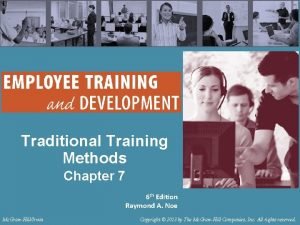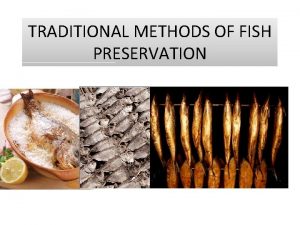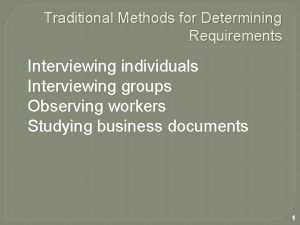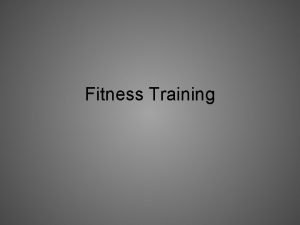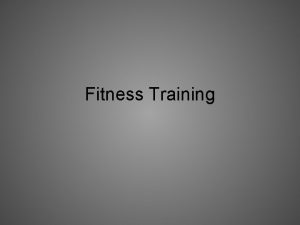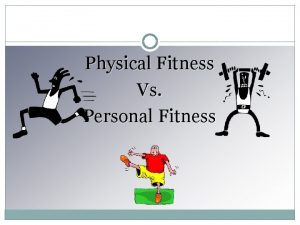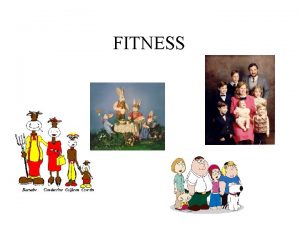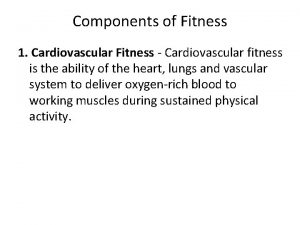Training Methods High Performance Functional Fitness Traditional training









- Slides: 9

Training Methods High Performance

Functional Fitness Traditional training methods focused on specific exercises and specific muscles • More modern training methods focus on specific items like speed, agility, quickness, strength, and flexibility. Typically these are done in more sport like situations. • Main methods used to meet individual training needs: periodization, flexibility, core, cardio, resistance, circuit, plyometrics, speed agility quickness, balance training. •

Periodization • Refers to the development of an overall training plan separated into distinct training periods. • This will maximize performances at peak times and reduce injury and burnout. • Pre- season, in season, and off season • Example: Pre-season – preparatory phase has 3 phases: hypertrophy (or base phase), strength (increased volume and intensity), power (near competition levels and volume drop significantly) • In season – more sport specific training, volumes drop • Off Season – unstructured activities, maintain fitness

Flexibility • Increased in recognition in recent years • Age and gender are major limiting factors for improving flexibility • Many benefits: correction of muscle imbalances, decreased muscles stiffness, improved joint flexibility, decreased stress on joints, improved posture, and improved strength • Static, dynamic, yoga, self massage

Core Training • Involves the muscles in the back and abs • These muscles are used for stabilization, bracing • Severe injury risk if core strength is lacking • Dirty Dozen etc.

Cardiorespiratory Training (endurance) • 3 phases: Base Training, Interval Training, and Sport-specific training • Base – off season, these activities vary in duration and intensity • Interval – just prior to competitive season, lasts only a few weeks, very mentally draining • Eg. Interval workout for recreational runner looking to improve his/her 10 km performance – 6 -8 repetitions of 1000 meters at the athlete’s goal pace • Sport-specific – last phase and includes many sport specific drills • Typically a variety of speed, quickness and agility exercises will be included

Resistance Training • Weight lifting is most common • Great and most effective way to improve strength • Variables to take into account – order of exercises (large muscles to smaller ones), number of reps, number of sets, amount of rest, intensity, volume (weight lifted) and frequency of workouts

Circuit Training • Group of 4 – 10 exercises • Timed rest usually 10 – 45 seconds Plyometrics • Can develop strength and power • Uses one’s own body weight • Only to be used after one has developed a strong base

Speed/Agility/Quickness • Relates to strength and power, but also motor learning and control • Will decrease the risk of injury and improve performance • Exercise varieties Balance Training • Stabilization exercises • Eg. One legged, two foot hops etc.
 Traditional training methods
Traditional training methods Traditional training methods advantages and disadvantages
Traditional training methods advantages and disadvantages Health-related skills
Health-related skills Methods of fish preservation
Methods of fish preservation Traditional methods for determining requirements
Traditional methods for determining requirements Traditional methods of capital budgeting
Traditional methods of capital budgeting Band and loop space maintainer advantages
Band and loop space maintainer advantages Non functional plasma enzymes
Non functional plasma enzymes Enzymes
Enzymes Functional and non functional
Functional and non functional
